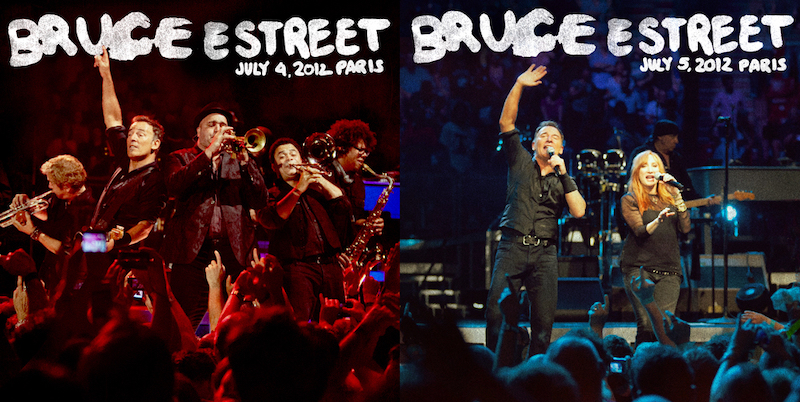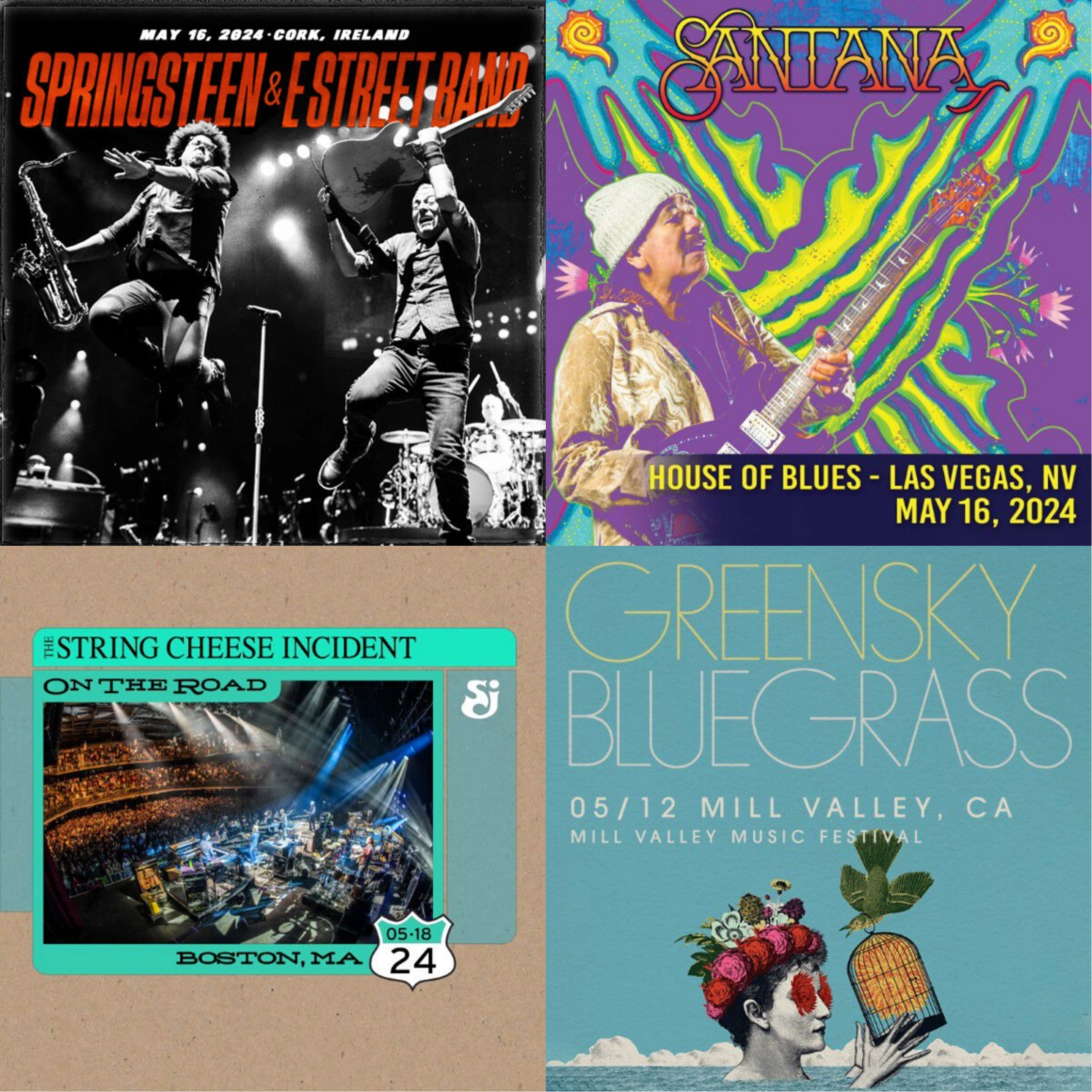Bruce Springsteen and The E Street Band in Paris, July 4 and 5, 2012

ARCHIVE RELEASE: Bruce Springsteen & The E Street Band live in Paris, July 4 and 5, 2012
The Hype Is Real
by Erik Flannigan
The Wrecking Ball tour was big on multiple levels, from the length of the shows (eventually reaching four hours, breaking Bruce’s all-time record), to the number of band members on stage (hitting 17 on occasion), to the scale of the venues—especially in Europe, where the 2012 tour hit stadiums across the continent… save for one special stand in Paris.
For reasons that have never been explained, when Springsteen brought the Wrecking Ball caravan to France to open the second half of the Euro leg, he downsized from stadiums back to arena-scale for just one pair of shows that fell on the fourth and fifth of July. Those back-to-back performances, which featured an impressive 44 different songs between them, have long been lauded as some of the best of the tour. In that spirit of bigness and in celebration of the ten-year anniversary of the gigs, it seemed only fitting to add both Paris 2012 shows to the Live Archive series.
The Paris concerts combined offer over seven hours of music and a bounty of special moments and performances. Here are several worth noting.
Bruce Springsteen & The E Street Band at Palais Omnisports De Paris-Bercy, July 4, 2012
The charms of the expanded 2012 band bear fruit in a delightful, unhurried version of “The E Street Shuffle” performed as a sign request. The song was played more in 2012 than any other year since 1975, when it thrived in a completely different arrangement. The Wrecking Ball tour edition takes advantage of the horn section, Everett Bradley’s percussion, and the E Street Choir on background vocals for a fully realized rendition that follows the original album structure of prelude, main song, and a storming, extended coda. In Paris, the crowd keeps singing the melody after the whole thing ends, indicative of just how into the show they are, and it compels Bruce to start the “E Street Shuffle” back up again for a second coda.
Springsteen keeps the Asbury Park setting, linking “Shuffle” to “Sandy” in his transition: “And then, down from town, about five blocks in on the boardwalk… if you listen hard, you could hear…” He sings the accordion-led, Fourth of July special in a low voice at times, adding a bit of age and wisdom to the tale, which on this night includes the sometimes-omitted third verse about the “waitress who lost her desire for me.” The background singers bring lushness to the final chorus as the sun sets on the boardwalk via Paris.
When Bruce opened his Fourth of July playlist for this show, he clicked them all—which means “Darlington County.” Stevie Van Zandt veers the song towards the edge of the Rolling Stones’ “Honky Tonk Women” before Bruce sings his first line about that memorable drive he and Wayne took from New York City all those years ago. The Paris take is long, with an extended horn and sax section at the end.
With Patti back on stage for the first time on the Euro tour, “Easy Money” returns to the set in one of only 18 performances ever. Bruce’s untamed falsetto vocals start things out, and one has to credit the Paris crowd for their consistently high level of participation as they sing along strongly here. Patti’s vocal contributions are a key element to “Easy Money,” which is why the song wasn’t performed without her.
In the most special nod to the occasion, Bruce moves to the piano for a rare solo-piano performance of “Independence Day.” Bruce released a video of this version in 2012 on his official YouTube channel, and it is great to have the audio available through the Live Archive series. Having played the instrument every night of the Devils & Dust tour, Springsteen’s piano playing is more confident than ever. Listen to the fine solo he takes in lieu of Clarence’s memorable sax before the third verse. Like so many older songs performed in this era, the bit of age in Springsteen’s voice only adds gravitas.
No Fourth of July performance would be complete without “Born in the U.S.A.” in its still-awe-inspiring, full-band arrangement. Bruce has no trouble finding his 1984 vocal range “forty years down the road” in a crackling rendition that puts the electric guitars on a level playing field with the synthesizers. Max Weinberg is also up to the task: while the horns add heft to the outro, Max smashes his legendary fills as hard as ever.
ARCHIVE RELEASE: Bruce Springsteen & The E Street Band live in Paris, July 4 and 5, 2012
Bruce Springsteen & The E Street Band at Palais Omnisports De Paris-Bercy, July 5, 2012
If anyone needed a sign that the second show in Paris would be materially different from the first, look no further than the top of the set when Bruce and the band reel off six songs in a row not featured the previous night. Deviating from his own written setlist, the band starts what sounds for all the world like “We Take Care of Our Own” only to shift gears into a bright “The Ties That Bind,” led by Roy Bittan’s piano and rich with the voices of the background singers in the chorus and bridge. Jake Clemons takes a sharp solo, too. The stellar reading of “Ties” is followed in bang-bang succession by breathtaking runs of “No Surrender,” “Two Hearts,” “Downbound Train,” “Candy’s Room,” and lastly a scintillating “Something in the Night.” Fans in attendance said the July 5 show was truly something special, and you can hear that imprinted in Jon Altschiler’s full-bodied mix. The six-song start of the second Paris set is as good as it gets in the post-Reunion era.
In all, Paris night two boasts 15 changes from the previous show, including three certified epics starting with “Incident on 57th Street.” As vocal as they have been all night, the Paris audience treats the Wild & Innocent masterpiece with fitting reverence. Bruce tells Nils to take the initial guitar lead, which rises above Charlie Giordano’s swirling organ.
“Working on the Highway” and “I’m Goin’ Down” add a dose of levity and self-deprecation to the evening. The horn section and background singers give “Working on the Highway” a big jolt of energy, while the audience does the same for “I’m Goin’ Down,” yielding reinvigorated versions of both songs.
After a solo “Independence Day” on July 4, Bruce sits at the piano bench night two and delivers “For You.” This one is triumphant, reaching the heady heights of the song’s solo outings in 1975 (such as the extraordinary take on the Live Archive release of Greenvale, NY 12/12/75). Like “Indy” the night before, Springsteen plays the piano brilliantly, and he commits to every line of the lyrics to staggering effect. He also hits the last note resoundingly when he sings “When it was my turn to be the God.” As the kids say, “Chills.”
From “For You” straight into evening’s epic denouement, “Racing in the Street”—another time-defying performance. It can be difficult to describe in the written word what it feels like when a performer is in the moment, not simply performing their music, but embodying it, living the words and melodies anew. But you can hear it. That goes for every member of the band, too—special credit to Bittan and Bradley, first among equals in this performance of “Racing.”
The sequence of “For You” to “Racing in the Street,” and the top of the July 5 show as well, all capture Bruce Springsteen and the E Street Band performing in the moment. For years, they did so more consistently than any other band in concert. On this fantastic recording of Paris 2012, so many years down the road, they undeniably do so again.
ARCHIVE RELEASE: Bruce Springsteen & The E Street Band live in Paris, July 4 and 5, 2012
Erik Flannigan is a music archivist, producer, author and manager. He has been writing about Bruce Springsteen’s live performances and recordings for more than 30 years.



